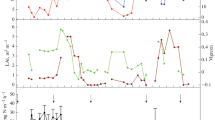Abstract
Highest rates of N2O emissions from fertilized as well as natural ecosystems have often been measured at spring thaw. But, it is not clear if management practices have an effect on winter and spring thaw emissions, or if measurements conducted over several years would reveal different emission patterns depending on winter conditions. In this study, we present N2O fluxes obtained using the flux-gradient approach over four winter and spring thaw periods, spanning from 1993 to 1996, at two locations in Ontario, Canada. Several agricultural fields (bare soil, barley, soybean, canola, grass, corn) subjected to various management practices (manure and nitrogen fertilizer addition, alfalfa ploughing, fallowing) were monitored. Nitrous oxide emissions from these fields from January to April over four years ranged between 0 and 4.8 kg N ha-1. These thaw emissions are substantial and should be considered in the nitrous oxide budgets in regions where thaw periods occur. Our study indicates that agricultural management can play a role in mitigating these emissions. Our data show that fallowing, manure application and alfalfa incorporation in the fall lead to high spring emissions, while the presence of plants (as in the case of alfalfa or grass) can result in negligible emissions during thaw. This presents an opportunity for mitigation of N2O emissions through the use of over-wintering cover crops.
Similar content being viewed by others
References
Berard R & Thurtell GW (1990) Soil temperature measurements. In: Goel NS & Norman JM (eds) Instrumentation for Studying Vegetation Canopies for Remote Sensing in Optical and Thermal Infra-red Regions, pp 293-300. Glasgow, UK: Remote Sensing Reviews 5, Harwood Academic
Cates RL & Keeney DR (1987) Nitrous oxide production throughout the year from fertilized and manured maize fields. J Environm Qual 16: 443-447
Chen Y, Tessier S, MacKenzie AF & Laverdière MR (1995) Nitrous oxide emission from an agricultural soil subjected to different freeze-thaw cycles. Agric Ecosys Environm 55: 123-128
Christensen S & Christensen BT (1991) Organic matter available for denitrification in different soil fractions: effect of freeze/thaw cycles and straw disposal. J Soil Sci 42: 637-647
Christensen S & Tiedje JM (1990) Brief and vigorous N2O production by soil at spring thaw. J Soil Sci 41: 1-4
Denmead OT & Raupach MR (1993) Methods for measuring atmospheric gas transport in agricultural and forest systems. In: Harper LA et al. (eds) Agricultural Ecosystem Effects on Trace Gases and Global Climate Change, pp 19-44. ASA Spec Publ 55. Madison, Wisc: ASA, CSSA, and SSSA
Edwards GC, Neumann HH, den Hartog G, Thurtell GW& Kidd GE (1994) Eddy correlation measurements of methane fluxes using a tunable diode laser at the Kinosheo Lake tower site during the Northern Wetlands Study (NOWES). J Geophys Res 99: 1511-1517
Flessa H & Dörsch P (1995) Seasonal variation of N2O and CH4 fluxes in differently managed arable soils in southern Germany. J Geophys Res 100: 23115-23124
Goodroad LL & Keeney DR (1984a) Nitrous oxide emission from forest, marsh, and prairie ecosystems. J Environm Qual 13: 448-452
Goodroad LL & Keeney DR (1984b) Nitrous oxide emissions from soils during thawing. Can J Soil Sci 64: 187-194
Goodroad LL, Keeney DR & Peterson LA (1984) Nitrous oxide emissions from agricultural soils in Wisconsin. J Environm Qual 13: 557-561
Isermann K (1994) Agriculture's share in the emission of trace gases affecting the climate and some cause-oriented proposals for sufficiently reducing this share. Environ Pollut 83: 95-111
Melin J & Nommik H (1983) Denitrification measurements in intact soil cores. Acta Agri Scand 33: 145-151
Mosier AR, Duxbury JM, Freney JR, Heinemeyer O & Minami K (1996) Nitrous oxide from agricultural fields: assessment, measurement and mitigation. Plant and Soil 181: 95-108
Sommerfeld RA, Mosier AR & Musselman RC (1993) CO2, CH4 and N2O flux through a Wyoming snowpack and implications for global budgets. Nature 361: 140-142
Tel DA & Heseltine C (1990) The analyses of KCl soil extracts for nitrate, nitrite and ammonium using a TRAACS 800 analyzer. Commun Soil Sci Plant Anal 21: 1681-1688
Van Bochove E, Jones HG, Pelletier F & Prévost D (1996) Emission of N2O from agricultural soil under snow cover: a significant part of N budget. Hydrol Proc 10: 1545-1549
Wagner-Riddle C, Thurtell GW, King KM, Kidd GE & Beauchamp EG (1996) Nitrous oxide and carbon dioxide fluxes from a bare soil using a micrometeorological approach. J Environ Qual 25: 898-907
Wagner-Riddle C, Thurtell GW, Kidd GK, Beauchamp EG & Sweetman R (1997) Estimates of Nitrous Oxide Emissions from Agricultural Fields over 28 months. Can J Soil Sci 77: 135-144
Watson RT, Rodhe H, Oeschger H & Siegenthaler U (1990) Greenhouse gases and aerosols. In: Houghton JT et al. (eds) Climate Change: The IPCC Scientific Assessment, pp 7-40. Cambridge Univ Press, Cambridge, UK
Rights and permissions
About this article
Cite this article
Wagner-Riddle, C., Thurtell, G. Nitrous oxide emissions from agricultural fields during winter and spring thaw as affected by management practices. Nutrient Cycling in Agroecosystems 52, 151–163 (1998). https://doi.org/10.1023/A:1009788411566
Issue Date:
DOI: https://doi.org/10.1023/A:1009788411566




